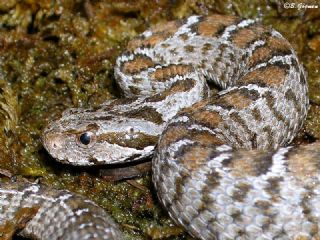Anatolian Viper Snake
Category: Snakes

Facts about Anatolian Viper snake. "Scientific name for Anatolian Viper snake is Vipera albizona". The Anatolian Viper snake originates from central Turkey and a Swedish herpetologist discovered it in 1989 while he was conducting his regular fieldwork. The exact location is not known because of conservations reasons since it is considered as an endangered species. It is closely related to Ottoman Viper and some herpetologists are debating whether Anatolian Viper qualifies to be its own species. This rare Anatolian Viper makes a home in a small area of the Mediterranean forest in the Taurus Mountains and IUCN classifies this species as an endangered species.
The Anatolian Viper snake has only been seen recently in a protected cedar forest reserve. Because little is known about the Anatolian Viper snake, the Mohamed bin Zayed Species Conservation Fund was commissioned specially to carry out extensive research on this species. This was meant to know the specific habitat and behaviors of this viper so that it can be protected. Even though there was disagreement among herpetologists, the Anatolian Viper snake was officially considered a full species in 2001.
Conservation Status of Anatolian Viper snake
This is one of the vipers, which is not classified as the Least Concern (LC) by the IUCN red list of endangered snake species. The Anatolian Viper snake has been list as a threatened species because it does not enjoy wide distribution as other vipers. The Anatolian viper is strictly located to the Mountains of Turkey and since it was first considered as a species of its own and not a sub-class of Ottoman Viper, there are very few species of the Anatolian Viper snake, which have been spotted. In fact, the Anatolian Viper snake is listed under the strictly protected under the Berne Convention.
Physical Characteristics of Anatolian Viper snake
The Anatolian Viper is marked by a black zigzag stripe often beautifying its white or grey dorsally body. There are also some melanistic types of these vipers. Keeled dorsal scales feature them. They are moderate growing vipers in the Turkish forests and the total body length including head and tail ranges from 70 to 95 cm. (27 5/8 to 37 1/2 inches). They may reach a maximum length of 130 cm (51 inches) on good and favorable conditions on particular Greek islands in the Aegean Sea. The Anatolian Viper snake do well in humid areas and they like and grow optimally in well-vegetated areas rocky mountains and forests.
Geographical Distribution of Anatolian Viper snake
They type of locality these vipers occupy are classified scientifically as Xanthus meaning Southwestern Turkey and some parts of Asia Minor. They are thought to grow well in rainy forests as well as rocky mountains where they can find a place to hide where they prey for small animals.
The Anatolian Viper snake were common in the European Turkey, Patmos, Kalimnos, Kos, Northeastern Greece, Greek Islands of Simi and the Islands of the Turkish mainland shelf. They may also be found in Lesbos, western half of Antolia, Leros and Lispos.
Diet of Anatolian Viper snake
Just like other venomous vipers, the Anatolian Viper preys mostly on rodents and other small mammals and even birds. They prey also on reptiles such as lizards as well. They are good hunters and they feed mostly on small animals.
Venom And Bite of Anatolian Viper snake
There is no specific anti-venom, which is recommended by the Viper Antitoxin European, Viper Venom Antitoxin, and World Health Organization listed anywhere. They are venomous vipers and their bites may be very fatal.

 Back To Category Snakes
Back To Category Snakes